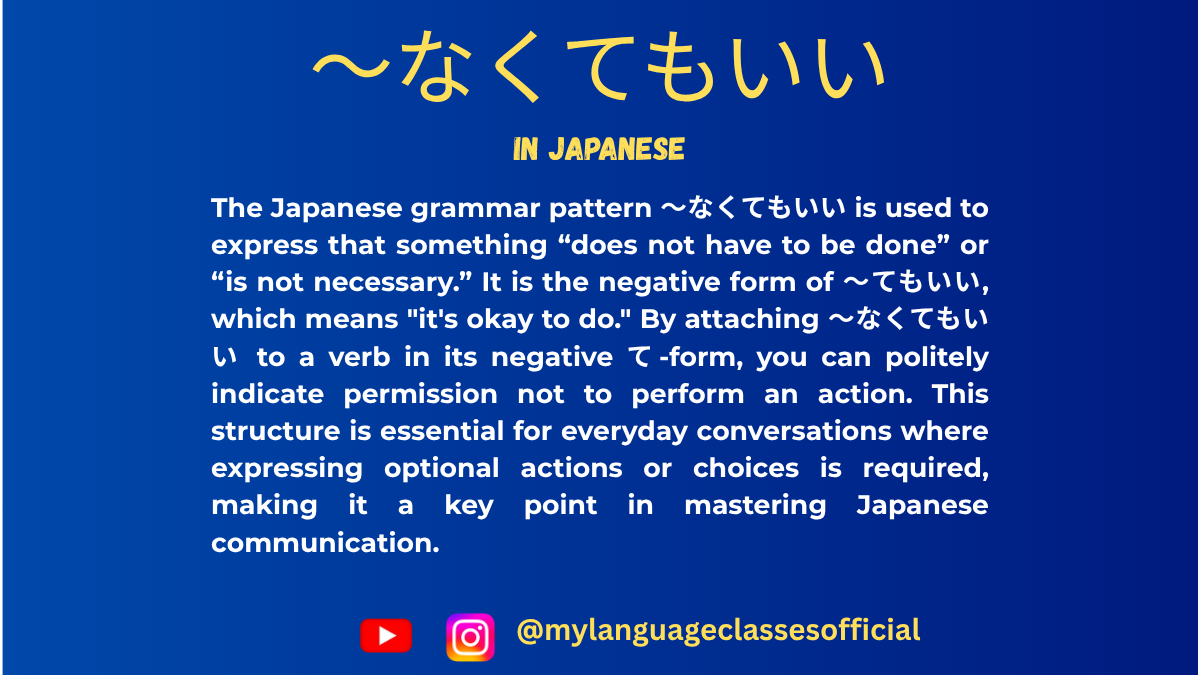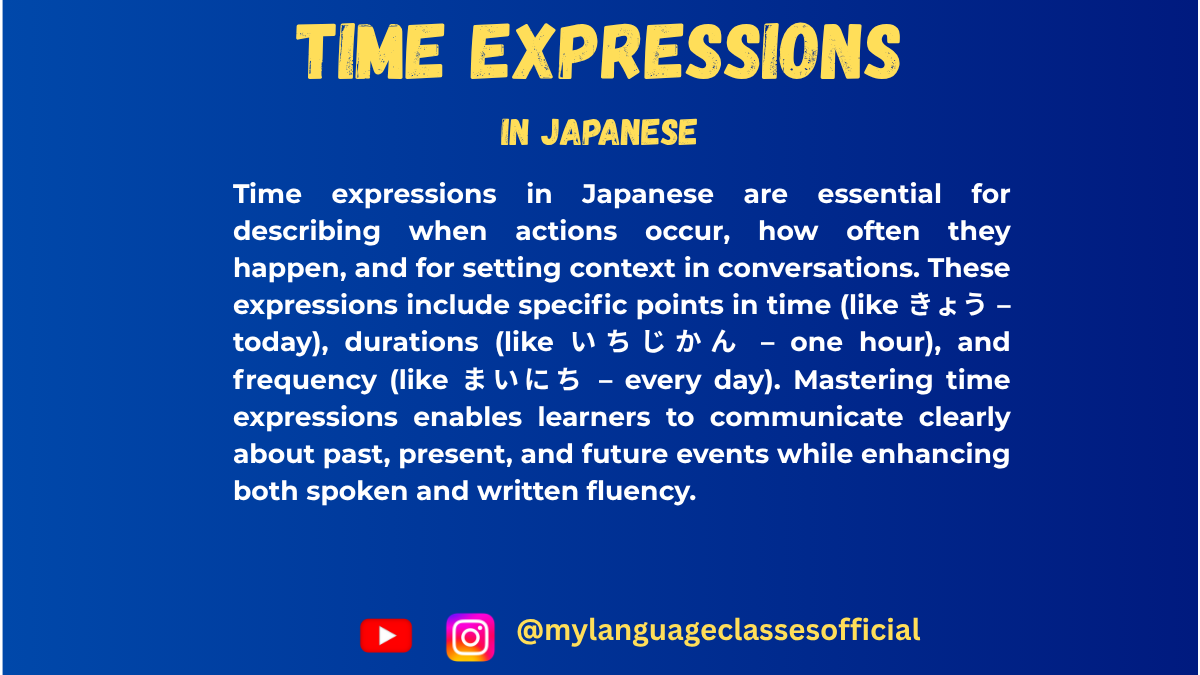Your cart is currently empty!
Tag: JAPANESE
-
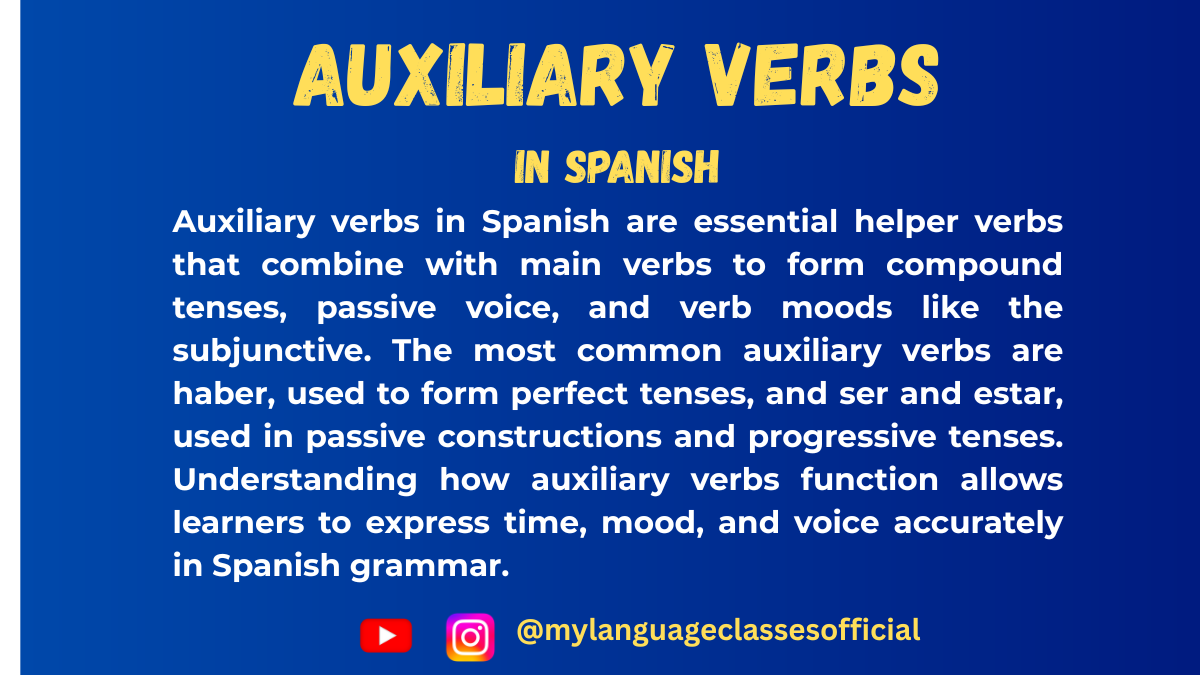
Auxiliary Verbs in Spanish: A Complete Guide
Auxiliary verbs, or “verbos auxiliares” in Spanish, play a crucial role in forming various tenses, moods, and grammatical structures. They are used in conjunction with main verbs to express nuances such as obligation, ability, probability, or temporality. Understanding auxiliary verbs is essential for mastering Spanish fluency.
Common Auxiliary Verbs in Spanish
- Haber (to have – for perfect tenses)
- Ser (to be – for passive voice and descriptions)
- Estar (to be – for progressive tenses and states)
- Tener que (to have to – for obligations)
- Deber (must/should – for necessity and advice)
- Poder (can – for ability and permission)
- Ir a (going to – for future actions)
- Querer (to want – for desires and intentions)
- Soler (to usually – for habitual actions)
1. Haber: Forming Perfect Tenses
Haber is used as an auxiliary verb to form compound tenses like the present perfect, past perfect, and future perfect.
Conjugation of Haber (Present Indicative):
- Yo he
- Tú has
- Él/Ella/Usted ha
- Nosotros/as hemos
- Vosotros/as habéis
- Ellos/Ellas/Ustedes han
Example Sentences:
- Yo he comido hoy. (I have eaten today.)
- ¿Has visto la película? (Have you seen the movie?)
Things to Keep in Mind:
- The past participle always remains unchanged (e.g., comido, visto, escrito).
- Haber must be conjugated in the correct tense and subject agreement.
2. Ser and Estar: Expressing Passive Voice and Progressive Tenses
- Ser is used for the passive voice and permanent characteristics.
- Estar is used for the present progressive tense and temporary conditions.
Conjugation of Ser (Present Indicative):
- Yo soy
- Tú eres
- Él/Ella/Usted es
- Nosotros/as somos
- Vosotros/as sois
- Ellos/Ellas/Ustedes son
Conjugation of Estar (Present Indicative):
- Yo estoy
- Tú estás
- Él/Ella/Usted está
- Nosotros/as estamos
- Vosotros/as estáis
- Ellos/Ellas/Ustedes están
Example Sentences:
- La puerta es cerrada por el profesor. (The door is closed by the teacher.)
- Estoy estudiando español. (I am studying Spanish.)
3. Tener que, Deber, and Poder: Expressing Obligation, Necessity, and Ability
- Tener que + infinitive: Expresses strong obligation.
- Ejemplo: Tengo que trabajar mañana. (I have to work tomorrow.)
- Deber + infinitive: Expresses necessity or recommendation.
- Ejemplo: Debes hacer ejercicio. (You should exercise.)
- Poder + infinitive: Expresses ability or permission.
- Ejemplo: ¿Puedes ayudarme? (Can you help me?)
4. Ir a + Infinitive: Talking About the Near Future
This structure is similar to the English “going to.” It is commonly used in spoken Spanish.
Example Sentences:
- Voy a viajar a España. (I am going to travel to Spain.)
- ¿Vas a llamar a tu madre? (Are you going to call your mother?)
5. Querer and Soler: Expressing Intentions and Habits
- Querer + infinitive: Expresses desire.
- Ejemplo: Quiero aprender español. (I want to learn Spanish.)
- Soler + infinitive: Expresses habitual actions.
- Ejemplo: Suelo leer antes de dormir. (I usually read before sleeping.)
Conjugation of Regular and Irregular Verbs in Auxiliary Verb Constructions
Spanish verbs fall into three categories: -AR, -ER, and -IR verbs.
Regular Verb Conjugation in the Present Participle (Gerundio)
- -AR verbs: hablar → hablando (speaking)
- -ER verbs: comer → comiendo (eating)
- -IR verbs: vivir → viviendo (living)
Past Participle Formation (Used with Haber)
- -AR verbs: hablar → hablado
- -ER verbs: comer → comido
- -IR verbs: vivir → vivido
Irregular Past Participles
- Decir → dicho (said)
- Hacer → hecho (done)
- Ver → visto (seen)
- Escribir → escrito (written)
List of Common Expressions with Auxiliary Verbs
Here are some daily expressions using auxiliary verbs:
- ¿Has comido? (Have you eaten?)
- Voy a salir ahora. (I am going to leave now.)
- Puedes ayudarme, por favor. (Can you help me, please?)
- Debemos estudiar más. (We must study more.)
- Tienes que llamar a tu madre. (You have to call your mother.)
Things to Keep in Mind
- Gender and Plurality: Auxiliary verbs themselves do not change for gender, but past participles used with “ser” must agree in gender and number (e.g., “La tarea fue hecha.”)
- Use of Articles: In general, articles (el, la, los, las) are necessary with nouns but not with infinitive verbs.
- Reflexive Verbs: When using auxiliary verbs with reflexive verbs, place the reflexive pronoun before the auxiliary verb or attach it to the infinitive (e.g., “Me voy a duchar” / “Voy a ducharme”).
Final Thoughts
Mastering auxiliary verbs in Spanish is essential for building more complex sentences and improving fluency. Understanding when and how to use “haber,” “ser,” “estar,” “tener que,” and other auxiliary verbs will help you navigate Spanish conversations with ease. Keep practicing with real-life examples, and soon, using these verbs will become second nature!
¿Quieres seguir aprendiendo? (Do you want to keep learning?) Stay tuned for more Spanish lessons!
If you enjoyed this lesson, be sure to check out more posts like this on my blog at My Language Classes. Don’t forget to subscribe my YouTube channel and follow me on Instagram for the latest language learning tips and lessons. Leave a comment below to share your thoughts, or ask any questions you have.
Happy learning! 😊
-
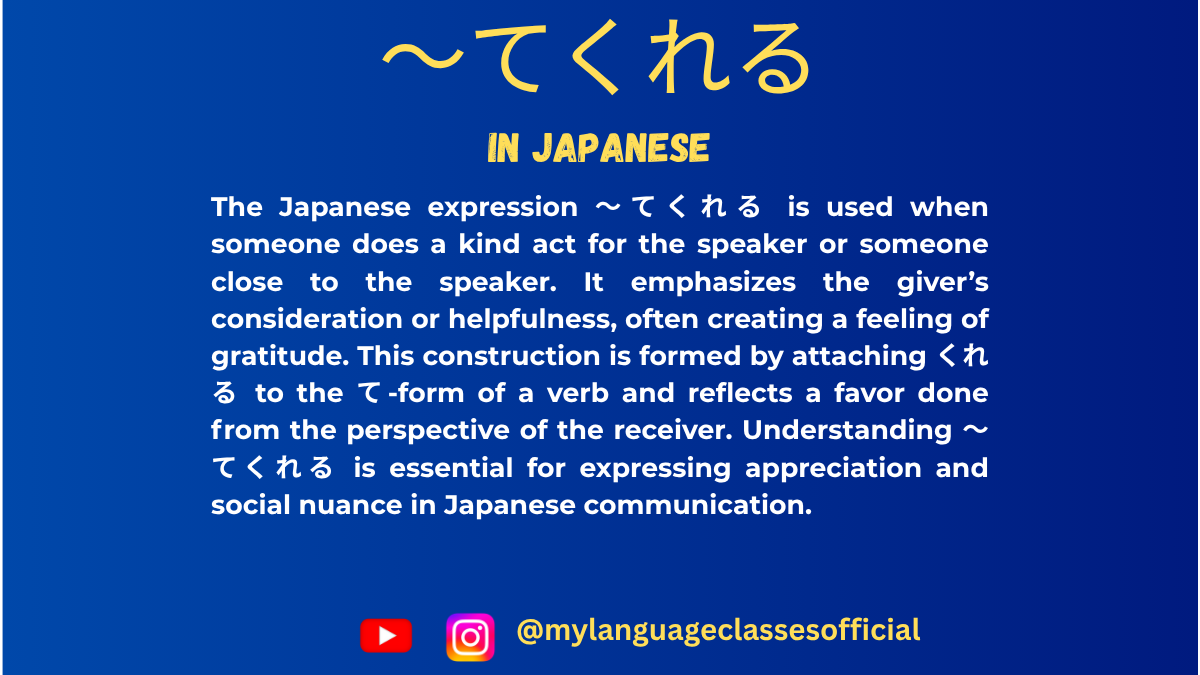
How to Use 〜てくれる | My Language Classes
Understanding “〜てくれる” in Japanese
The Japanese expression 〜てくれる is a key grammatical structure used to describe actions done for the speaker’s benefit or someone close to them. It conveys gratitude and appreciation towards the doer. Let’s explore its usage in various contexts and provide a list of situations where “〜てくれる” is used.
What is 〜てくれる?
“〜てくれる” is derived from the verb くれる, which means “to give.” When attached to the て-form of a verb, it expresses that someone performs an action for the speaker (or someone in the speaker’s inner circle). It implies a sense of appreciation and goodwill.
- Structure:
[Person] が [Verb (て-form)] くれる
(Someone does something for me or someone in my group.) - Example:
- 友達が宿題を手伝ってくれた。
(Tomodachi ga shukudai o tetsudatte kureta.)
→ “My friend helped me with my homework.” - 先生が日本語を教えてくれました。
(Sensei ga Nihongo o oshiete kuremashita.)
→ “The teacher kindly taught me Japanese.”
- 友達が宿題を手伝ってくれた。
Situations Where 〜てくれる is Used
1. When Someone Helps You
Used when someone provides assistance that benefits the speaker.
- Example:
- 兄が荷物を運んでくれた。 (Ani ga nimotsu o hakonde kureta.)
→ “My older brother carried my luggage for me.”
- 兄が荷物を運んでくれた。 (Ani ga nimotsu o hakonde kureta.)
2. When Someone Gives You Something
Used when someone gives you an object (related to くれる itself).
- Example:
- 友達がプレゼントを買ってくれた。 (Tomodachi ga purezento o katte kureta.)
→ “My friend bought me a present.”
- 友達がプレゼントを買ってくれた。 (Tomodachi ga purezento o katte kureta.)
3. When Someone Does a Favor for You
Used when someone voluntarily does something kind.
- Example:
- 彼が傘を貸してくれた。 (Kare ga kasa o kashite kureta.)
→ “He lent me an umbrella.”
- 彼が傘を貸してくれた。 (Kare ga kasa o kashite kureta.)
4. When Someone Teaches or Instructs You
Used when someone imparts knowledge or skills.
- Example:
- 先生が漢字の書き方を教えてくれた。 (Sensei ga kanji no kakikata o oshiete kureta.)
→ “The teacher taught me how to write kanji.”
- 先生が漢字の書き方を教えてくれた。 (Sensei ga kanji no kakikata o oshiete kureta.)
5. When Someone Listens to You
Used when someone listens or gives attention to you.
- Example:
- 友達が悩みを聞いてくれた。 (Tomodachi ga nayami o kiite kureta.)
→ “My friend listened to my worries.”
- 友達が悩みを聞いてくれた。 (Tomodachi ga nayami o kiite kureta.)
6. When Someone Accompanies You
Used when someone goes with you somewhere.
- Example:
- 母が病院まで一緒に行ってくれた。 (Haha ga byouin made issho ni itte kureta.)
→ “My mother went to the hospital with me.”
- 母が病院まで一緒に行ってくれた。 (Haha ga byouin made issho ni itte kureta.)
7. When Someone Encourages or Supports You
Used when someone gives encouragement.
- Example:
- 彼が試験の前に励ましてくれた。 (Kare ga shiken no mae ni hagemashite kureta.)
→ “He encouraged me before the exam.”
- 彼が試験の前に励ましてくれた。 (Kare ga shiken no mae ni hagemashite kureta.)
8. When Someone Waits for You
Used when someone waits patiently for you.
- Example:
- 友達が駅で待ってくれた。 (Tomodachi ga eki de matte kureta.)
→ “My friend waited for me at the station.”
- 友達が駅で待ってくれた。 (Tomodachi ga eki de matte kureta.)
9. When Someone Fixes or Repairs Something for You
Used when someone fixes something for your benefit.
- Example:
- 父が自転車を直してくれた。 (Chichi ga jitensha o naoshite kureta.)
→ “My father fixed my bicycle.”
- 父が自転車を直してくれた。 (Chichi ga jitensha o naoshite kureta.)
10. When Someone Invites You or Gives You a Treat
Used when someone invites or pays for you.
- Example:
- 彼がコーヒーをおごってくれた。 (Kare ga koohii o ogotte kureta.)
→ “He treated me to coffee.”
- 彼がコーヒーをおごってくれた。 (Kare ga koohii o ogotte kureta.)
Notes on Usage
- Subject Consideration:
- The giver of the action is the grammatical subject, not the receiver.
- Example:
- 彼がケーキを作ってくれた。 (He made a cake for me.)
- 私にケーキを作ってくれた is unnatural (omit 私に).
- Politeness Levels:
- Casual: 〜てくれる
- Polite: 〜てくれます
- Past polite: 〜てくれました
- Not Used for Superior-to-Subordinate Actions:
- You cannot use 〜てくれる when a subordinate (like a junior worker) does something for a superior (like a boss). Instead, use 〜てくださいました (keigo).
Conclusion
The expression 〜てくれる is an essential part of Japanese communication, showing gratitude when someone does something beneficial for the speaker. By understanding the different contexts in which it is used, learners can express appreciation naturally and appropriately in Japanese conversations.
Do you have any questions about 〜てくれる? Let me know in the comments! 😊
If you enjoyed this lesson, be sure to check out more posts like this on my blog at My Language Classes. Don’t forget to subscribe my YouTube channel and follow me on Instagram for the latest language learning tips and lessons. Leave a comment below to share your thoughts, or ask any questions you have about nouns.
Happy learning! 😊
- Structure:
-
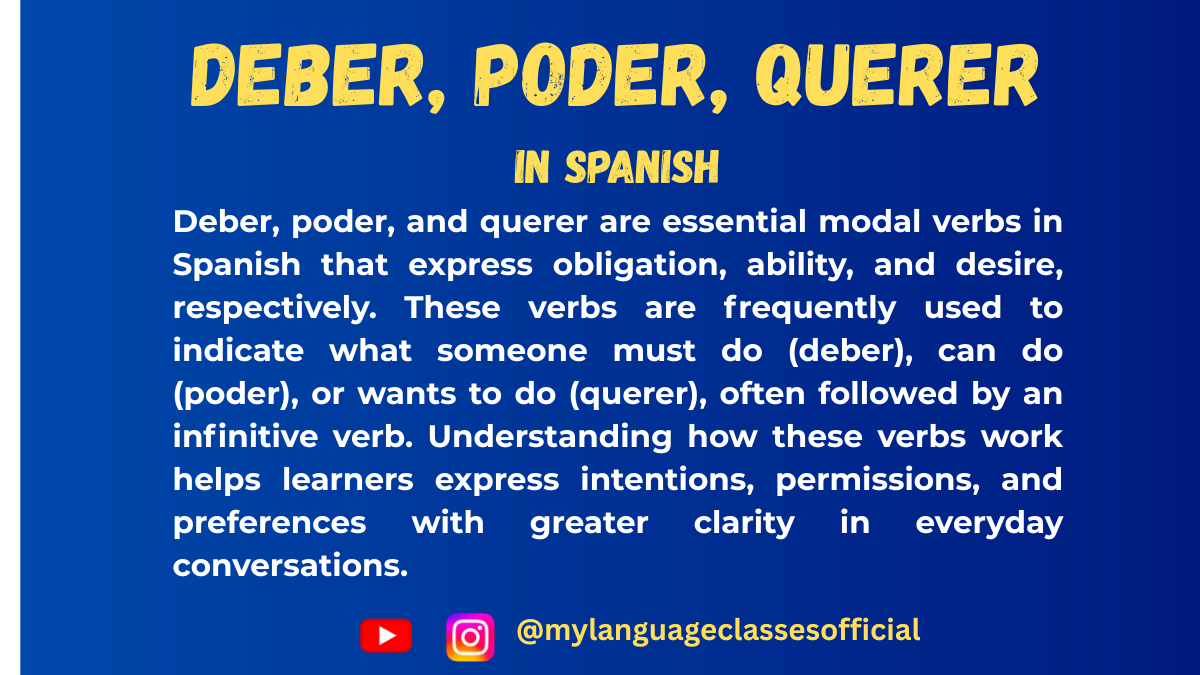
Deber, Poder, Querer: Expressing Obligation, Possibility, and Desire in Spanish
In Spanish, the verbs deber, poder, and querer are commonly used to express obligation, possibility, and desire, respectively. Understanding how to use these verbs correctly is essential for fluent communication. In this blog post, we will explore their meanings, conjugations, and common expressions used in daily life.
1. Deber – Expressing Obligation
The verb deber translates to “must” or “should” in English and is used to indicate duty, necessity, or moral obligation.
Common Expressions with Deber
- Deber + infinitivo → “Must/should do something.”
- Debo estudiar para el examen. (I must study for the exam.)
- Debes comer más verduras. (You should eat more vegetables.)
- Deber de + infinitivo → Expresses probability or supposition.
- Debe de estar en casa. (He/She must be at home.)
Conjugation of Deber
Tense Conjugation Present Indicative debo, debes, debe, debemos, debéis, deben Preterite debí, debiste, debió, debimos, debisteis, debieron Imperfect debía, debías, debía, debíamos, debíais, debían Present Subjunctive deba, debas, deba, debamos, debáis, deban Imperative (no direct affirmative imperative; use subjunctive)
2. Poder – Expressing Possibility and Ability
The verb poder means “can” or “to be able to.” It is used to express ability, permission, or possibility.
Common Expressions with Poder
- Poder + infinitivo → “To be able to do something.”
- Puedo nadar bien. (I can swim well.)
- No puedes entrar sin permiso. (You can’t enter without permission.)
- ¿Se puede…? → Asking for permission.
- ¿Se puede fumar aquí? (Can one smoke here?)
- No poder más → “To be unable to handle something anymore.”
- No puedo más con este calor. (I can’t take this heat anymore.)
Conjugation of Poder (Irregular Verb)
Tense Conjugation Present Indicative puedo, puedes, puede, podemos, podéis, pueden Preterite pude, pudiste, pudo, pudimos, pudisteis, pudieron Imperfect podía, podías, podía, podíamos, podíais, podían Present Subjunctive pueda, puedas, pueda, podamos, podáis, puedan Imperative (no direct affirmative imperative; use subjunctive)
3. Querer – Expressing Desire and Intentions
The verb querer means “to want” or “to love.” It is used to express desires, wishes, and sometimes affection.
Common Expressions with Querer
- Querer + infinitivo → “To want to do something.”
- Quiero viajar a España. (I want to travel to Spain.)
- ¿Quieres salir esta noche? (Do you want to go out tonight?)
- Querer a alguien → “To love someone.”
- Te quiero mucho. (I love you a lot.)
- Querer decir → “To mean.”
- ¿Qué quiere decir esta palabra? (What does this word mean?)
Conjugation of Querer (Irregular Verb)
Tense Conjugation Present Indicative quiero, quieres, quiere, queremos, queréis, quieren Preterite quise, quisiste, quiso, quisimos, quisisteis, quisieron Imperfect quería, querías, quería, queríamos, queríais, querían Present Subjunctive quiera, quieras, quiera, queramos, queráis, quieran Imperative (no direct affirmative imperative; use subjunctive)
Key Considerations When Using Deber, Poder, Querer
- Articles and Gender:
- Use el, la, los, las with nouns when necessary.
- Example: Debes respetar las reglas. (You must respect the rules.)
- Plural vs. Singular:
- Conjugate the verb based on the subject.
- Example: Ellos pueden hablar inglés. (They can speak English.)
- Using the Subjunctive:
- Often follows expressions of doubt, wishes, or hypothetical scenarios.
- Example: Quiero que vengas conmigo. (I want you to come with me.)
- Negation:
- Use “no” before the verb to make it negative.
- Example: No debes mentir. (You must not lie.)
Conclusion
Mastering deber, poder, and querer is essential for effective communication in Spanish. These verbs allow you to express obligation, possibility, and desire in various situations. By understanding their conjugations, common expressions, and proper grammatical usage, you will significantly enhance your Spanish fluency. Keep practicing, and soon, you’ll be able to use them naturally in conversations!
If you enjoyed this lesson, be sure to check out more posts like this on my blog at My Language Classes. Don’t forget to subscribe my YouTube channel and follow me on Instagram for the latest language learning tips and lessons. Leave a comment below to share your thoughts, or ask any questions you have.
Happy learning! 😊
- Deber + infinitivo → “Must/should do something.”
-

How to Use 〜てもらう | My Language Classes
The Japanese Grammar 〜てもらう
The Japanese grammar pattern 〜てもらう is an essential structure used to express receiving a favor from someone. It emphasizes that someone is doing something beneficial for the speaker or a third party. Understanding this grammar is crucial for natural and polite Japanese communication.
This post will explain 〜てもらう in various situations, provide example sentences, and list common contexts where it is used.
Structure of 〜てもらう
The pattern follows this structure:
Person A (receiver) + は/が + Person B (doer) + に + Verb in 〜て form + もらう
- A is the person who benefits from the action.
- B is the person performing the action for A.
- The verb is conjugated into the て-form and followed by もらう (to receive).
Example:
- 私は先生に日本語を教えてもらいました。
(I had my teacher teach me Japanese.)
Difference Between 〜てもらう and 〜てあげる
- 〜てもらう: Focuses on the receiver of the favor.
- 〜てあげる: Focuses on the giver of the favor.
Example:
- 私は先生に日本語を教えてもらいました。 (I received Japanese lessons from my teacher.)
- 私は先生に日本語を教えてあげました。 (I taught Japanese to my teacher.)
Various Situations Where 〜てもらう Is Used
1. Receiving Help
When someone helps you with a task or does something for your benefit.
Example:
- 私は彼氏に財実を送ってもらいました。
(I had my boyfriend send my wallet.)
2. Receiving Permission
Used when asking for permission to do something.
Example:
- 先生にはやく帰らせてもらいました。
(I got permission from my teacher to leave early.)
3. Receiving a Favor Indirectly
You receive a favor, but a third party performs the action.
Example:
- 母は先生にむすこの学校の事を説明してもらいました。
(My mother had the teacher explain about the school to her.)
4. Making Polite Requests
When requesting someone to do something politely.
Example:
- この文章を正しく直してもらえますか。
(Could you please correct this text for me?)
5. Receiving Information
When someone shares knowledge or guidance.
Example:
- 先生にいろいろな情報を教えてもらいました。
(I received a lot of information from my teacher.)
6. Asking for Medical Assistance
Used when getting treatment or medical help from someone.
Example:
- 医者に病治をしてもらいました。
(I got treated by the doctor.)
7. Receiving a Physical Object
Used when someone gives you something.
Example:
- 友人に好きな本を買ってもらいました。
(My friend bought me a book I like.)
8. Receiving Guidance or Instructions
Used when someone teaches you or gives instructions.
Example:
- 先生に作文の書き方を教えてもらいました。
(I had my teacher teach me how to write essays.)
Summary of Situations Where 〜てもらう Is Used
Here’s a quick reference list:
- Receiving help (task-related support)
- Receiving permission
- Receiving a favor indirectly
- Making polite requests
- Receiving information or knowledge
- Asking for medical assistance
- Receiving a physical object
- Receiving guidance or instructions
Conclusion
〜てもらう is a crucial grammar point in Japanese, allowing you to express receiving favors, help, or benefits from others. Mastering this structure enhances your ability to communicate politely and effectively in various situations. Practice using it in conversations to improve fluency and comprehension!
If you enjoyed this lesson, be sure to check out more posts like this on my blog at My Language Classes. Don’t forget to subscribe my YouTube channel and follow me on Instagram for the latest language learning tips and lessons. Leave a comment below to share your thoughts, or ask any questions you have about nouns.
Happy learning! 😊
-
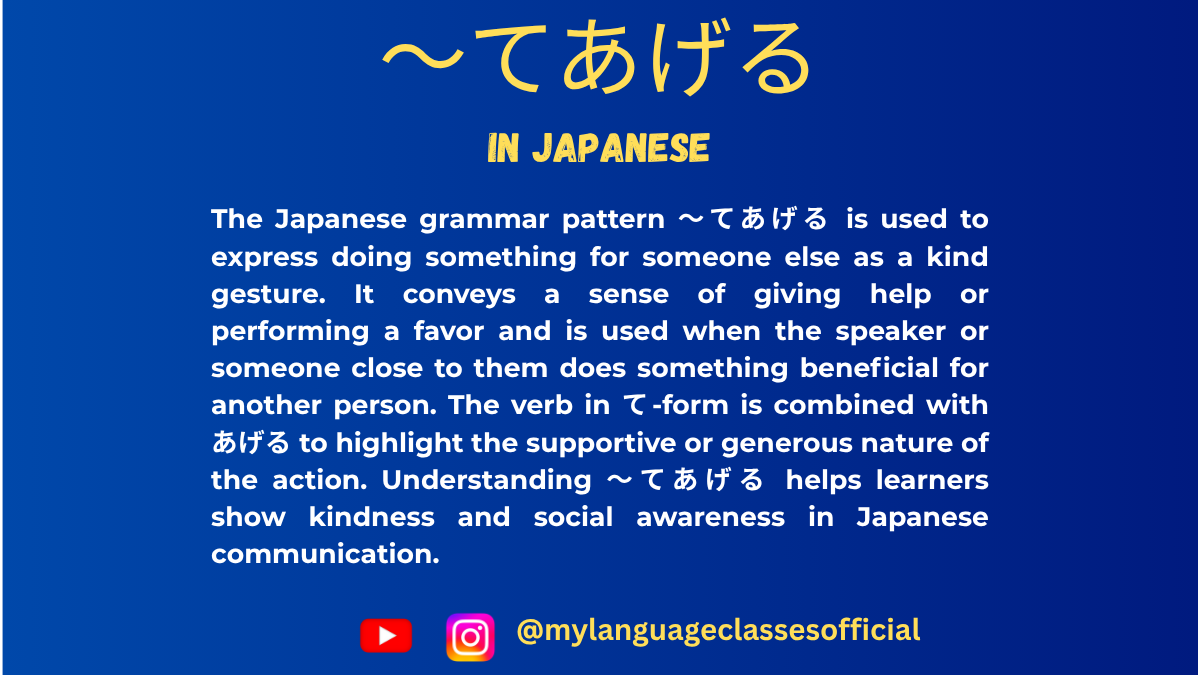
How to Use 〜てあげる | My Language Classes
〜てあげる: To Give (an Action) in Japanese
When learning Japanese, you will often encounter the phrase 〜てあげる (te ageru), which means “to give (an action).” This phrase is used when the speaker or someone performs a beneficial action for another person. The nuance of 〜てあげる is that the action is done out of kindness or generosity.
How to Use 〜てあげる
The structure is simple:
[Person] は [Recipient] に [Action in 〜て-form] + あげる
Example:
- わたしは ともだち に 本を 貸してあげました。
(Watashi wa tomodachi ni hon o kashite agemashita.)
→ I lent a book to my friend (as a favor).
Different Forms of 〜てあげる
The verb あげる can be conjugated into different forms to match the politeness level:
Form Usage 〜てあげる Casual/plain form 〜てあげます Polite form 〜てあげて Te-form for requests 〜てあげない Negative form (not doing the action) 〜てあげなかった Past negative form Situations Where 〜てあげる Is Used
1. Doing Something Nice for Someone Else
- わたしは ちょうとせんせい に にもつを 持ってあげました。
(Watashi wa chouto sensei ni nimotsu o motte agemashita.)
→ I carried the teacher’s luggage for them.
2. Helping Someone
- おとうさんは ぼくに 自転車の修理を してあげた。
(Otousan wa boku ni jitensha no shuuri o shite ageta.)
→ Dad fixed my bicycle for me.
3. Giving Advice or Instruction
- わたしは ともだち に 日本語 を 教えてあげる。
(Watashi wa tomodachi ni nihongo o oshiete ageru.)
→ I will teach my friend Japanese.
4. Buying Something for Someone
- おかあさんは いもうと に 花を 買ってあげました。
(Okaasan wa imouto ni hana o katte agemashita.)
→ Mom bought flowers for my little sister.
5. Making a Favorable Gesture
- 私は 友達 に コーヒーを 作ってあげました。
(Watashi wa tomodachi ni koohii o tsukutte agemashita.)
→ I made coffee for my friend.
6. Expressing Kindness in a Relationship
- けんたろうは かのじょに マッサージを かいてあげた。
(Kentaro wa kanojo ni massaaji o kaite ageta.)
→ Kentaro gave his girlfriend a massage.
7. Helping Children or Animals
- おねえさんは 犬 に 食べ物 を あげてあげた。
(Oneesan wa inu ni tabemono o agete ageta.)
→ The older sister gave food to the dog.
Things to Remember About 〜てあげる
- Used when the action is beneficial: You should only use 〜てあげる when the action is helpful or kind.
- Do not use for superiors: Avoid using 〜てあげる when speaking about actions for a superior (e.g., boss, teacher) as it may sound rude. Instead, use 〜てさしあげる.
- Casual tone: This phrase is often used in informal or everyday conversations rather than in formal writing.
Summary Table: When to Use 〜てあげる
Situation Example Helping a friend はさみを 買ってあげた。 (Bought scissors for them.) Teaching someone えいご を 教えてあげる。 (Teach English to them.) Doing a favor 部屋を 掃除してあげる。 (Clean the room for them.) Helping animals 犬 に 飯 を あげてあげる。 (Give food to a dog.) By mastering 〜てあげる, you can express kindness and generosity in Japanese naturally! Practice using it in real conversations to make your speech sound more fluent and native-like.
Do you have any questions about 〜てあげる? Let me know in the comments!
If you enjoyed this lesson, be sure to check out more posts like this on my blog at My Language Classes. Don’t forget to subscribe my YouTube channel and follow me on Instagram for the latest language learning tips and lessons. Leave a comment below to share your thoughts, or ask any questions you have about nouns.
Happy learning! 😊
- わたしは ともだち に 本を 貸してあげました。
-
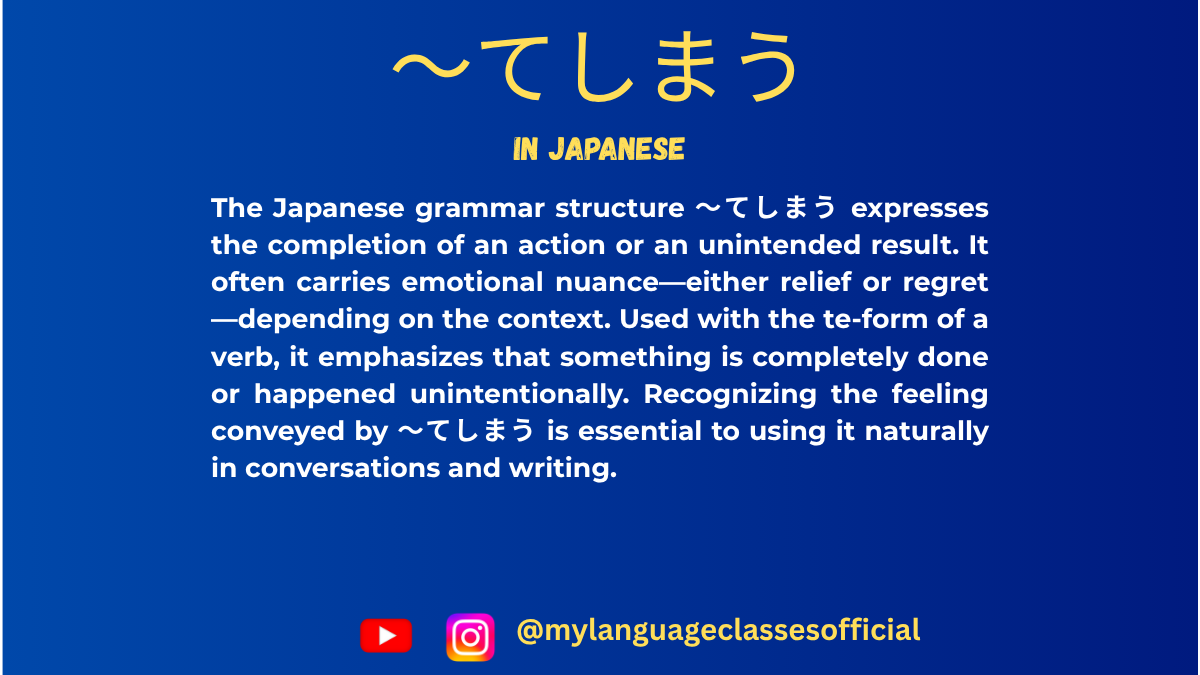
Expressing Completion or Regret in Japanese:〜てしまう| My Language Classes
Using 〜てしまう in Japanese
In Japanese, the grammar structure 〜てしまう plays a significant role in expressing either the completion of an action or a sense of regret, often depending on the context. This nuanced construction can elevate your Japanese proficiency, helping you convey subtle emotions and intentions effectively.
Let’s delve into its usage, nuances, and common situations where it applies.
What is 〜てしまう?
The form 〜てしまう is derived by attaching しまう to the て-form of a verb. The meaning can vary based on context, and it is commonly shortened in casual speech to 〜ちゃう or 〜じゃう.
- Completion: Indicates that an action has been entirely or thoroughly completed.
- Regret/Unintended Outcome: Expresses a sense of regret, disappointment, or that something happened unintentionally.
How to Form 〜てしまう
- Take the て-form of the verb.
- Example: 飲む (to drink) → 飲んで
- Add しまう.
- 飲んでしまう (to finish drinking or drink unintentionally)
Casual Contractions:
- 〜てしまう → 〜ちゃう
- 飲んでしまう → 飲んじゃう
- 〜でしまう → 〜じゃう
- 食べてしまう → 食べちゃう
Situations Where 〜てしまう is Used
- Expressing Completion of an Action
- Used to indicate that an action is finished, often with a sense of thoroughness or finality.
- Example:
- 宿題を全部やってしまいました。 (I finished all my homework.)
- ケーキを食べてしまった。 (I ate the entire cake.)
- Expressing Regret or an Unintended Outcome
- When an action leads to an unintended or regrettable result.
- Example:
- 大事な書類をなくしてしまった。 (I lost an important document.)
- 電車に傘を忘れてしまいました。 (I accidentally left my umbrella on the train.)
- Expressing Uncontrollable Situations
- Used to convey situations beyond the speaker’s control.
- Example:
- 窓が風で閉まってしまった。 (The window shut because of the wind.)
- Expressing Emotional Impact
- Can emphasize feelings of surprise, disappointment, or unintended consequences.
- Example:
- こんなに早く雨が降ってしまうなんて思わなかった。 (I didn’t think it would start raining so soon.)
- Hypothetical or Future Concerns
- Used when imagining an unintended or regretful scenario in the future.
- Example:
- テストで間違えてしまうかもしれない。 (I might make a mistake on the test.)
Key Points to Remember
- Context is Crucial:
- Depending on the situation, 〜てしまう can mean either “to finish” or “to regret.” The tone, verb, and surrounding context clarify its intended meaning.
- Shortened Forms are Common:
- In casual conversation, the contracted forms ちゃう and じゃう are more commonly used.
- Polite vs. Casual Speech:
- Formal: 書いてしまいました。 (I finished writing.)
- Casual: 書いちゃった。 (I finished writing.)
- Adding Emotional Nuance:
- Using 〜てしまう adds depth to your expression, allowing you to highlight feelings of regret, completion, or an unexpected event.
Examples of Common Scenarios
Situation Example Sentence Translation Accidental Action コーヒーをこぼしてしまいました。 (I accidentally spilled the coffee.) Forgot Something 鍵を家に忘れてしまった。 (I left my keys at home.) Regretful Action 寝坊してしまった。 (I overslept.) Uncontrollable Event 雨が降ってしまった。 (It started raining.) Complete Action 本を全部読んでしまいました。 (I finished reading the entire book.) Hypothetical Concern 試験に遅れてしまうかもしれない。 (I might be late for the exam.)
Why Use 〜てしまう?
- Adds Emotional Depth:
- Helps convey your feelings of regret, surprise, or relief.
- Expresses Finality:
- Perfect for emphasizing the completion of an action.
- Natural and Fluent Japanese:
- Using 〜てしまう naturally in conversation makes your Japanese sound more native-like.
Practice Tip: Try incorporating 〜てしまう in daily life scenarios or journaling your day in Japanese. Write about actions you completed, unintended events, or things you regretted doing.
Example Practice Sentence:
- 昨日、友達に秘密を言ってしまいました。 (Yesterday, I accidentally told my friend a secret.)
By mastering 〜てしまう, you’ll enhance your ability to express subtle emotions and actions naturally, making your Japanese more dynamic and expressive.
If you enjoyed this lesson, be sure to check out more posts like this on my blog at My Language Classes. Don’t forget to subscribe my YouTube channel and follow me on Instagram for the latest language learning tips and lessons. Leave a comment below to share your thoughts, or ask any questions you have about nouns.
Happy learning! 😊
-

Understanding 〜でしょう/だろう in Japanese | My Language Classes
Expressions used to indicate probability, conjecture, or seeking confirmation
If you’re diving into the world of Japanese grammar, the particle でしょう (deshou) is one you’ll encounter frequently. It’s a versatile expression that conveys probability, speculation, or seeks confirmation. In this blog post, we’ll explore all the nuances of でしょう, its various uses, and how it interacts with other elements of the language.
1. What is でしょう?
でしょう is the polite form of だろう, which itself is derived from the copula だ (used to state facts). Depending on the context and tone, it can mean:
- “Probably”
- “I suppose”
- “Right?” (as a tag question seeking agreement)
- “It seems that”
Forming でしょう
- Nouns/Na-adjectives:
Add でしょう after the plain form.
Example:
学生 でしょう。 (It’s probably a student.) - I-adjectives:
Attach directly to the base form.
Example:
暑い でしょう。 (It’s probably hot.) - Verbs:
Attach to the plain form.
Example:
行く でしょう。 (He/she/they will probably go.)
2. Expressing Probability
One of the most common uses of でしょう is to express probability or likelihood. It’s often used when the speaker wants to indicate that something is likely true based on their knowledge or perception.
Examples:
- 明日は雨が降る でしょう。
(It will probably rain tomorrow.) - あの映画は面白い でしょう。
(That movie is probably interesting.)
In these cases, でしょう is equivalent to saying “probably” or “I think” in English. It softens the statement, showing that the speaker is not asserting something as a definite fact.
3. Asking for Confirmation
When used with a rising intonation, でしょう turns into a tag question, seeking agreement or confirmation from the listener. It can be translated as “right?” or “isn’t it?” in English.
Examples:
- このケーキ、美味しい でしょう?
(This cake is delicious, isn’t it?) - 彼は先生 でしょう?
(He’s a teacher, right?)
The rising tone at the end signals the speaker is looking for confirmation or agreement.
4. Making Guesses or Predictions
You’ll often hear でしょう in weather forecasts, news reports, or any context where predictions are made.
Examples:
- 明日の天気は晴れ でしょう。
(Tomorrow’s weather will probably be sunny.) - この問題は簡単 でしょう。
(This problem is probably easy.)
In such cases, the speaker uses でしょう to make a statement that isn’t 100% certain but is backed by reasonable evidence or context.
5. でしょう in Casual Speech: だろう
In informal situations, だろう is often used instead of でしょう, especially by men. While だろう serves the same functions, it feels less polite and more casual.
Examples:
- あれは本物のダイヤモンド だろう。
(That’s probably a real diamond.) - 今日は忙しい だろう?
(You’re busy today, right?)
6. Negative Forms
The negative equivalent of でしょう is formed by negating the predicate or verb.
Examples:
- あのレストランは高くない でしょう。
(That restaurant is probably not expensive.) - 彼は来ない でしょう。
(He probably won’t come.)
7. Using でしょう in Hypothetical or Conditional Contexts
When paired with the conditional たら or similar structures, でしょう can express speculation about hypothetical situations.
Examples:
- あの店に行ったら、何か美味しいものがある でしょう。
(If we go to that store, there will probably be something delicious.) - もっと勉強したら、試験に合格する でしょう。
(If you study more, you will probably pass the exam.)
8. Cultural Nuances and Subtleties
In Japanese communication, でしょう plays a role in maintaining politeness and avoiding direct assertions. By using でしょう, the speaker softens their statements, allowing room for the listener’s interpretation or input. This aligns with Japanese cultural norms that emphasize indirectness and respect for others’ perspectives.
For example:
- 今日は寒いです。 (It’s cold today.)
→ Direct and factual. - 今日は寒いでしょう。 (It’s probably cold today.)
→ Politer, leaving room for the listener’s agreement or alternative opinion.
9. Common Pitfalls and Misunderstandings
- でしょう vs かもしれない:
Both express uncertainty, but かもしれない conveys a lower degree of certainty compared to でしょう.
Example:
彼は来る でしょう。 (He will probably come.)
彼は来る かもしれない。 (He might come.) - Overuse in Confirmation Questions:
While でしょう is great for seeking agreement, overusing it can make your speech sound repetitive. Balance it with other expressions like よね or ね for variety.
10. Final Notes
Mastering でしょう allows you to add nuance to your Japanese and navigate conversations more smoothly. It’s a fantastic tool for expressing uncertainty politely, making predictions, or asking for confirmation. Remember:
- Use でしょう for polite speech and だろう for casual contexts.
- Pay attention to intonation when seeking confirmation.
- Practice with real-life scenarios to internalize its subtleties.
Do you have any questions about でしょう or other Japanese grammar points? Share them in the comments below, and let’s learn together! 😊
If you enjoyed this lesson, be sure to check out more posts like this on my blog at My Language Classes. Don’t forget to subscribe my YouTube channel and follow me on Instagram for the latest language learning tips and lessons. Leave a comment below to share your thoughts, or ask any questions you have about nouns.
Happy learning! 😊
-
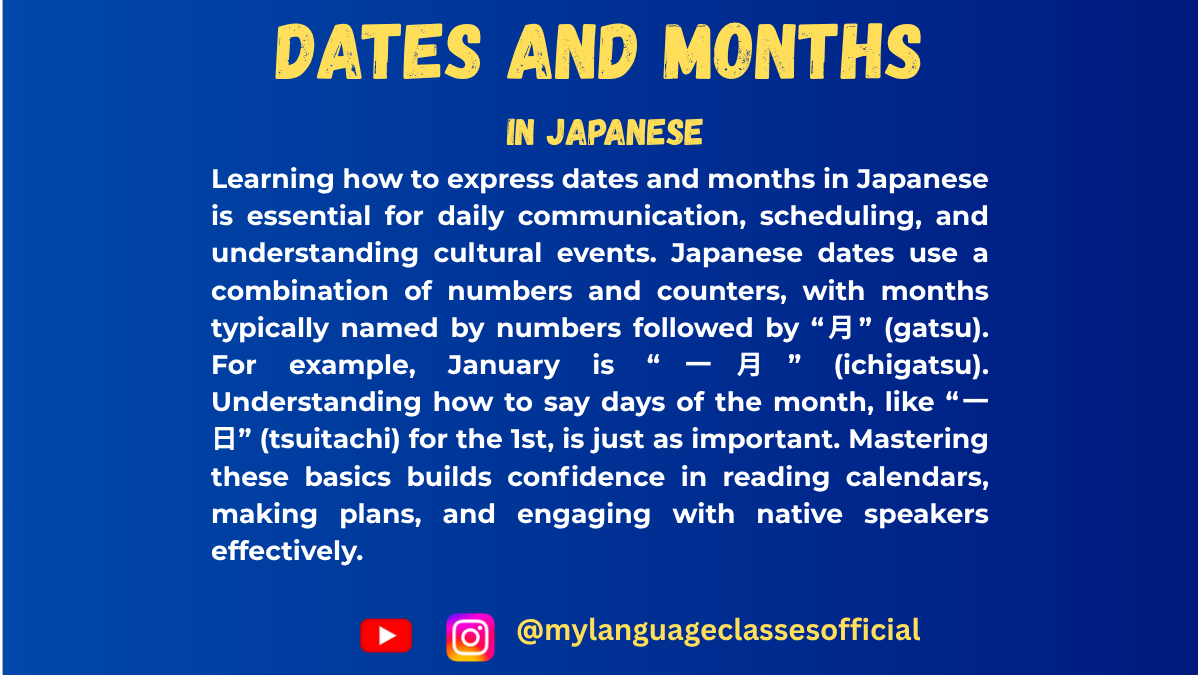
Mastering Dates and Months in Japanese | My Language Classes
Dates and Months in Japanese
こんにちは (Konnichiwa)!
If you’re learning Japanese, one of the essential skills is telling the date. Japanese has unique ways to express dates that differ from English or many other languages. In this post, we’ll cover everything you need to know about telling dates in Japanese, including a handy list of how to say specific dates and some cultural and linguistic nuances to keep in mind. Let’s dive in!
Understanding Japanese Dates: Basic Structure
In Japanese, the date format is typically written as Year-Month-Day (e.g., 2024年12月25日, 2024-12-25). The characters used are:
- 年 (nen) for “year”
- 月 (gatsu) for “month”
- 日 (nichi) for “day”
For example:
- 2024年12月25日 = “2024 December 25”
- Read as: にせんにじゅうよねん じゅうにがつ にじゅうごにち (Nisen-nijūyo-nen, jūni-gatsu, nijūgo-nichi)
Days of the Month in Japanese
Japanese has specific terms for the first 10 days and certain other days of the month. Here’s a list of the most common:
1st to 10th and 20th (Special Readings):
- 1日 (ついたち) – Tsuitachi
- 2日 (ふつか) – Futsuka
- 3日 (みっか) – Mikka
- 4日 (よっか) – Yokka
- 5日 (いつか) – Itsuka
- 6日 (むいか) – Muika
- 7日 (なのか) – Nanoka
- 8日 (ようか) – Yōka
- 9日 (ここのか) – Kokonoka
- 10日 (とおか) – Tōka
- 20日 (はつか) – Hatsuka
Days After the 10th:
For days after the 10th (except 20th), simply use the number + 日 (にち, nichi). For example:
- 11th = 11日 (じゅういちにち) – Jūichi-nichi
- 12th = 12日 (じゅうににち) – Jūni-nichi
- 13th = 13日 (じゅうさんにち) – Jūsan-nichi
Continue this pattern up to the 31st:
- 21st = 21日 (にじゅういちにち) – Nijūichi-nichi
- 30th = 30日 (さんじゅうにち) – Sanjū-nichi
- 31st = 31日 (さんじゅういちにち) – Sanjūichi-nichi
Months in Japanese
Months in Japanese are much simpler. They are numbered from 1 to 12 followed by 月 (gatsu). For example:
- January = 1月 (いちがつ) – Ichigatsu
- February = 2月 (にがつ) – Nigatsu
- March = 3月 (さんがつ) – Sangatsu …and so on.
Key Grammar and Usage Notes
1. No Articles:
Unlike English, Japanese does not use articles like “the” or “a.” So, you simply state the date without worrying about additional words.
2. No Plural Forms:
Japanese nouns do not have plural forms. For example, the word 日 (nichi) stays the same whether you’re talking about one day or many days.
3. Gender-neutral Language:
Japanese does not have gender-specific nouns or articles. The way you say dates remains the same regardless of who is speaking or listening.
4. Pronunciation Challenges:
- Pay special attention to the unique readings for the 1st to 10th and the 20th.
- Be careful with long vowels, such as in ようか (8th), where the “ou” sound must be elongated.
5. Cultural Context:
When writing or saying the date in Japanese, it’s common to follow the year-month-day structure. If you’re addressing someone formally, especially in written communication, add です (desu) or でございます (de gozaimasu) for politeness.
Practice Makes Perfect!
Here’s an example of a complete date in Japanese:
- Today is December 25, 2024
→ 2024年12月25日です
→ にせんにじゅうよねん じゅうにがつ にじゅうごにち です
Pro Tips for Fluency
- Memorize the unique readings for the 1st to 10th and 20th – These are the most irregular and require rote learning.
- Practice with real dates – Try saying your birthday, important holidays, or even today’s date.
- Listen to native speakers – Watch Japanese TV shows, listen to podcasts, or use language apps to hear how dates are pronounced naturally.
Now that you’ve mastered dates in Japanese, try using them in conversation! Whether you’re booking an appointment or celebrating a special occasion, understanding how to express dates will bring you one step closer to fluency.
If you enjoyed this lesson, be sure to check out more posts like this on my blog at My Language Classes. Don’t forget to subscribe my YouTube channel and follow me on Instagram for the latest language learning tips and lessons. Leave a comment below to share your thoughts, or ask any questions you have about nouns.
Happy learning! 😊

